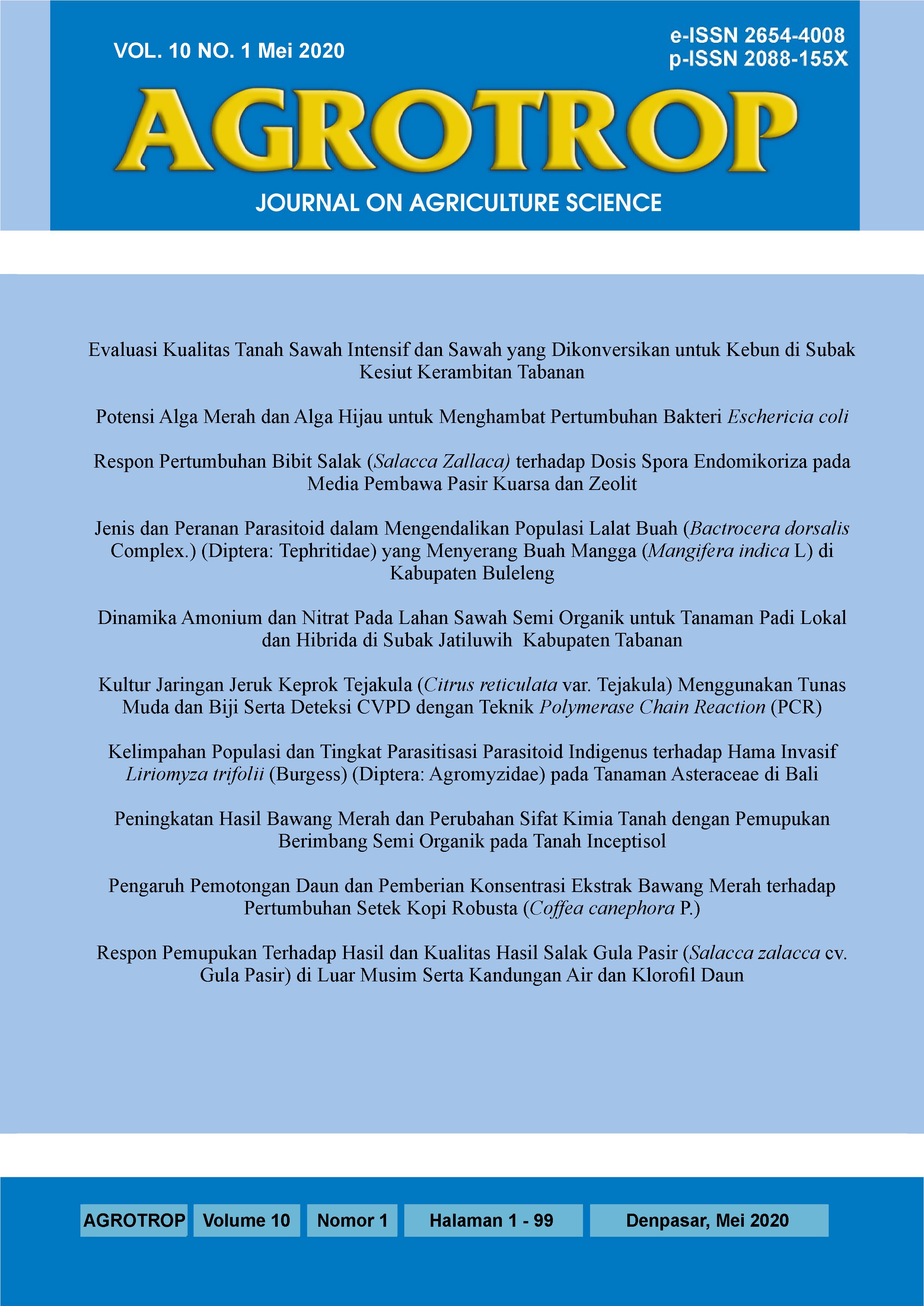Respon Pemupukan Terhadap Hasil dan Kualitas Hasil Salak Gula Pasir (Salacca zalacca cv. Gula Pasir) di Luar Musim Serta Kandungan Air Dan Klorofil Daun
Abstract
Fertilization Response to Off-Season Production and Fruit Quality of Salak Gula Pasir (Salacca Zalacca cv. Gula Pasir) and water and Chlorophyll Content of Leaves. Naturally salak Gula Pasir (Salacca zalacca cv. Gula Pasir) flowers every three months a year, but only one to two seasons of the flowers can develop into fruit. Failure of flowers develop into fruit, usually call fruit-set failure, causes the fruits be available seasonally in a short time period, only 2-3 months a year, i.e. during the harvest time (on-season period) from December to February. This research aimed to know response of fertilization to off-season production and fruits quality of salak Gula Pasir and its ralatinship to water and chlorophyll content of leaves. The study used a randomized block design with the treatment was fertilization, consists of 14 levels (fertilized according farmers’ way with leaf midrib only/control, fertilized with compost, mycorrhizal biofertilizer, inorganic NPK, combination of farmers' way and compost, combination of farmers’ way and mycorrhizal biofertilizer, combination of farmers' way and inorganic NPK, combination of compost and mycorrhizal biofertilizer, combination of compost and inorganic NPK, combination of mycorrhizal and inorganic NPK, combination of farmers’ way, compost, and mycorrhizal biofertilizer, combination of farmers’ way, compost, inorganic NPK, combination of farmers’ way, mycorrhizal biofertilizer and inorganic NPK, and combination of farmers’ way, compost, mycorrhizal biofertilizer, and inorganic NPK). Each treatment was repeated 3 times. The study was carried out in the off season period from April to Nopember 2018 at the production center of salak Gula Pasir plantation i.e. at Sibetan Village, Bebandem District, Karangasem Regency. The results showed that the highest fruit weight per tree at the off-season was obtained on combination of fertilization of farmers' way and mycorrhizal biofertilizer (of 2536.67 g) and the lowest was on control/fertilized according farmers’ way (1,220.00 g). Fertilization with compost, mycorrhizal biofertilizer, and inorganic NPK singly, or by combining it, increases the quality of off-season fruit of salak Gula Pasir, reflected by the increase of weight per fruit, fruit diameter and fruit sweetness compared to control. The lower of yield per tree and quality of fruit on control compared to other fertilization treatments was relate to low relative water content and chlorophyll content of leaves.
Downloads
References
Avio, L., C. Cristani, P. Strani, M. Giovannetti. 2009. Genetic and Phenotypic Diversity of Geographically Different Isolates of Glomus Mosseae. Canadian Journal of Microbiology 55: 242–253.
Baslam, M., I. Garmendia, N. Goicoechea. 2011. Arbuscular Mycorrhizal Fungi (AMF) Improved Growth and Nutritional Quality of Greenhouse-Grown Lettuce. Journal of Agricultural and Food Chemistry 59(10):5504-5515.
BPS (Badan Pusat Statistika) Provinsi Bali. 2017. Produksi Buah Salak Dirinci Menurut Kabupaten/Kota di Bali, 2010-2016. https://bali.bps.go.id/linkTableDinamis/view/id/130. [Diakses 20 Maret 2019].
Finlay, R.D. 2008. Ecological Aspects of Mycorrhizal Symbiosis: with Special Emphasis on the Functional Diversity of Interactions Involving the Extraradical Mycelium. Journal of Experimental Botany 5(5):1115-1126.
Hempel, S., G. Renker, F. Buscot. 2007. Differences in the Species Composition of Arbuscular Mycorrhizal Fungi in Spore, Root and Soil Communities in a Grassland Ecosystem. Environmental Microbiology 9:1930–1938.
Hernadi, P., Z. Sasvari, J. Albrechtova, M. Vosatka, K. Posta. 2012. Arbuscular Mycorrhizal Inoculants Increase Yield of Spice Pepper and Affects Indigenous Fungal Community in the Field. Hort Science 47(5): 603-606.
Jansa, J., F. Andrew Smith dan S. E. Smith. 2016. Are there benefits of simultaneous root colonization by different arbuscular mycorrhizal fungi.New Phytologist 177:779–789.
Kim, S. J., J. Eo. E. Lee, H. Park dan A. Eom. 2017. Effects of arbuscular mycorrhizal fungi and soil conditions on crop plant growth. Mycobiology. 45(1): 20-24.
Kirkby, E., 2012. Introduction, Definition and Classification of Nutrients. In “Marschner ‘s Mineral Nutrition of Higher Plants”, P. Marschner (ed.), Third edition. Academic Press, Elsevier. pp. 3-5
Kowalska, G. 2010. Flowering Biology of Manggo and Procedures Intensifying Fruit-set. Acta Scientiarum Polonorum, Hortorum Cultus 7(4):63-76.
Nurjanah, C.H., G. Sharma, K. Jindal. 2013. Flowering Biology of Manggo and Procedures Intensifying Fruit-set. Acta Scientiarum Polonorum, Hortorum Cultus 7(4):63-76.
Nurhandayani. 2013. Analisis Infeksi Akar Oleh Mikoriza. Diakses dari : http://digilib.unila.ac.id/14092/14/14-%20 Mikoriza%20II.pdf pada tanggal 12 Pebruari 2019.
Rai, I.N., C.G.A. Semarajaya, W. Wiraatmaja. 2010. A Study on the Flowering Phenophysiology of Gula Pasir Snake Fruit to Prevent Failure of Fruit-set. J. Hort. 20(3):216-222.
Rai, I.N., IW. Wiraatmaja, C.G.A. Semarajaya, N K. Alit Astiari. 2014. Application of Drip Irrigation Technology for Producing Fruit of Salak ‘Gula Pasir’ (Salacca Zalacca var. Gula Pasir) Off-Season on Dry Land. Journal of Degraded and Mining Lands Management 2(1)219-222.
Rai, I.N., C.G.A. Semarajaya, I W. Wiraatmaja, N K. Alit Astiari. 2016. Relationship between IAA, sugar content and fruit-set in snake fruit (Zalacca salacca). Journal of Applied Horticulture, 18(3): 213-216.
Soka, G. dan M. Ritchie. 2016. Contributions of AM fungi and soil organic matter to plant productivity in tropical savanna soils under different land uses. Rhizosphere. 4(1):1-8.
Sukewijaya, I. M., I. N. Rai, M. S. Mahendra. 2009. Development of Salak Bali as an Organic Fruit. Asian Journal of Food and Agro-Industry. Special Issue:37-43.Sadhana, B. 2014. Arbuscular Mycorrhizal Fungi (AMF) as a Biofertilizer: a Review. International Journal of Current Microbiology Applied Science 3(4): 384-400.
Sasvari, Z. F. Magurno1, D. Galanics, T. T. Nhu Hang, T. T. Hong Ha, N. D. Luyen, L. M. Huong, K. Posta. 2012. Isolation and Identification of Arbuscular Mycorrhizal Fungi from Agricultural Fields of Vietnam. American Journal of Plant Sciences 3:1796-1801.
Wang, F.Y., Z. Yong Shi. 2008. Biodiversity of Arbuscular Mycorrhizal Fungi in China: a Review. Advances in Environmental Biology 2(1): 31-39.
Wijana, G., K. Suter, C.G.A. Semarajaya, I.N. Rai. 1997. Upaya Pelestarian, Pengembangan dan Peningkatan Produksi Salak Kultivar Gula Pasir. Laporan Penelitian Hibah Bersaing I/5 Perguruan Tinggi Tahun Anggaran 1996/1997. Fakultas Pertanian Universitas Udayana.











